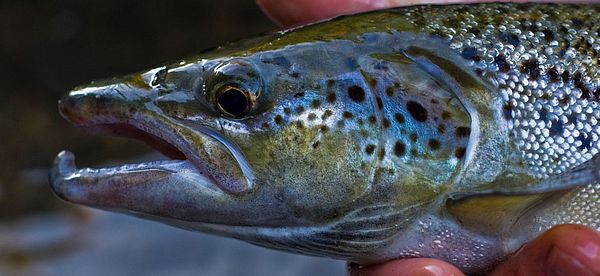Atlantic salmon spawning recently came to a close in Lake Champlain. Unlike their cousins in the Pacific Ocean, Atlantic salmon don’t typically die after spawning, but instead migrate back to the lake (or ocean) to feed.
Iridescent, delicious, and culturally significant, Atlantic salmon (Salmo salar) are prized in the northeast by anglers and the general public alike. Well-oxygenated, cold, deep, and fairly clear lakes, like Lake Champlain, are its primary habitat. As the seasons transition, so do salmon. In October and November, salmon move from the depths of Lake Champlain to spawn in the streams of the Lake Champlain Basin, such as the Boquet River in New York and the Winooski River in Vermont. Males swim beside the females, fertilizing her eggs. Female salmon then create nests in river bottoms to lay their eggs in, called redds, and cover them in gravel; the ideal location for redds is in swift water above or below pools, so the eggs are well-oxygenated. Eggs are incubated for approximately 150 days. Come April, fry (young with no attached yolk sac) emerge from the gravel to feed. Fry and parr (young exhibiting dark vertical bars, called parr marks) remain in the stream for one to three years before migrating back to their home lake.
This migration marks the transition of salmon young from parr to smolt and a key imprint: the smell of their home stream. Around the same time next year or the following year (some salmon spawn every other year), adults will follow the smell of their home rivers and return to begin the spawning cycle anew.
A century and a half ago, landlocked Atlantic salmon were abundant in Lake Champlain and its tributaries. Causes of their decline include dams, habitat degradation, overfishing, and pollution. Current salmon populations in the Lake are sustained by stocking efforts through the Lake Champlain Fish and Wildlife Management Cooperative, a partnership between the U.S. Fish & Wildlife Service, Vermont Fish and Wildlife Department, New York State Department of Environmental Conservation, other state agencies, universities, and research organizations. The Cooperative has worked alongside anglers, educators, and conservationists since the early 1970s to bring naturally reproducing populations back to the Lake. Biologists noted a five-year decline in the number of salmon that swam up the Winooski River to spawn in the fall of 2018. “Many river and lake factors influence fish returns,” noted Lee Simard, Fisheries Biologist with the Vermont Fish & Wildlife Department. Simard explained, “We’ve done a lot on Lake Champlain to get the salmon population and fisheries to where they are, but there are still a lot of unknowns that can be answered with ongoing monitoring and research projects.”
There is hope on the horizon. Data from the Lake Champlain Fish & Wildlife Management Cooperative concluded that naturally reproducing salmon fry were found in the Boquet in 2017 and 2019 and the Winooski River in 2016. Since the 2020 spawning season just finished, population statistics are not yet available. The survival of fry is important because it indicates that adult salmon are able to successfully reach their spawning habitat and subsequently, that young survive to the fry stage. Current threats to Atlantic salmon populations include dams and culverts that block access to spawning and rearing grounds, water quality degradation (sedimentation and water temperature), sea lamprey populations (keeping them in check), invasion by exotic species like alewife, and climate change.
If you want to learn more about Atlantic salmon’s disappearance in the Lake and efforts to re-establish populations, check out this 2017 five-part series from the U.S. Fish & Wildlife Service. Additionally, 2019 was the International Year of the Salmon; explore related resources compiled by the Lake Champlain Basin Program.
Nature Note: Spawning Salmon
Posted Thursday, December 31, 2020
—
General